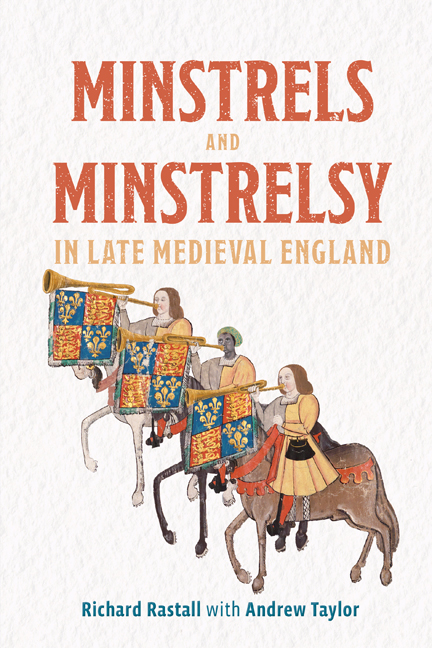Book contents
- Frontmatter
- Dedication
- Contents
- List of illustrations
- List of music examples
- List of abbreviations
- A note on references
- A note on money
- A note on dates
- Preface
- Acknowledgments
- Part I Minstrels and Minstrelsy in the Elite Households
- Part II Urban Minstrelsy
- Part III On the Road
- Part IV Minstrel Performance
- Envoi
- Bibliography
- Index
2 - The life of a royal minstrel
Published online by Cambridge University Press: 09 January 2024
- Frontmatter
- Dedication
- Contents
- List of illustrations
- List of music examples
- List of abbreviations
- A note on references
- A note on money
- A note on dates
- Preface
- Acknowledgments
- Part I Minstrels and Minstrelsy in the Elite Households
- Part II Urban Minstrelsy
- Part III On the Road
- Part IV Minstrel Performance
- Envoi
- Bibliography
- Index
Summary
Status and conditions of the minstrels
Fees and Wages
Payment to royal servants came in two ways, both probably in operation throughout the period covered by this book. Edward I paid a daily wage that applied when a servant was resident in Court, generally 7.d for a squire (scutifer) and 4.d for a yeoman (valettus). The other method of payment was as fees in the form of grants out of the income from property or by the gift of a particular post. This method is not always visible in the surviving records. Among royal minstrels paid in this way by Edward I was Gilbert the harper, who in 32 Ed I (1303/4) held lands in Chesterton (Warwickshire) by grand serjeanty, with the task of keeping Tiddersley Hay, in the Forest of Cannock, at his own cost. Income from the land held would more than pay for the costs of looking after Tiddersley Hay, if Gilbert had a good head for finance. Other fourteenth-century examples are William de Morley, who was granted property in Pontefract on 28 October 1322, Peter le fitheler and Peter le crouder. In 1405 the piper William Bingley was granted the office of bailiff of the town and lordship of Flint, with the due fees, wages, profits and other commodities, and with two cottages in Oundle and the reversion of a cottage in Fotheringay; and in 1413 William Haliday received a grant of £20 13s 4d per annum from the issues of properties. This was the method often used to pay non-royal servants, too: examples include William Wolston, trumpeter of the Earl of Northumberland, and Hugh Cook, trumpeter of Lord Beaumont.
The list of peace-time fees for 21 Ed III (1347/8), noted in Chapter 1, includes 19 minstrels and three ‘waytes’ (i.e. vigilatores), each at 20s 0d per annum. The items surrounding this are for five clerks of the chapel at 40s 0d each and, below the minstrels and waits, launderers at 26s 8d (i.e. two marks), messengers at 13s 4d (1 mark) and archers at 10s 0d.
- Type
- Chapter
- Information
- Minstrels and Minstrelsy in Late Medieval England , pp. 14 - 48Publisher: Boydell & BrewerPrint publication year: 2023

